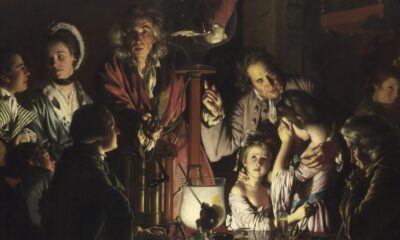Lifestyle
Joseph Wright’s 1768 Painting: Science, Art, and the Fate of a Bird

Joseph Wright of Derby’s painting, An Experiment on a Bird in the Air Pump, created in 1768, has sparked renewed interest following a recent review by art critic Jonathan Jones. The painting, currently featured in the exhibition at the National Gallery, portrays a dramatic scene that raises questions about life, death, and the ethics of scientific experimentation in the 18th century.
A key point of discussion focuses on the fate of the bird depicted in the artwork. In a segment aired on Radio 4 titled Moving Pictures in February, it was suggested that the bird may not actually die in the process depicted. The show highlighted that the air pump featured in Wright’s painting resembles those made by Benjamin Martin, which came with instructions for home experiments. One such experiment involved placing a live animal inside the pump, removing the air, and then at the last moment, restoring air to revive the creature.
This revelation provides a new perspective on why the observers in the painting appear so unfazed by the scene. According to the programme, it is possible that family members are aware of the experiment’s outcome, having seen similar demonstrations before. Such knowledge could explain their calm demeanor in the face of what seems to be a life-and-death situation for the bird.
While this artistic interpretation offers a glimpse into the scientific curiosity of the time, it also raises moral questions about the treatment of animals in the name of entertainment and education. The painting masterfully captures the tension between scientific exploration and ethical considerations, making it a compelling subject for both art and science enthusiasts.
Critics and audiences alike continue to engage with Wright’s work, reflecting on the broader implications of his art. The combination of science and visual storytelling in An Experiment on a Bird in the Air Pump not only illustrates the era’s intellectual climate but also invites viewers to ponder the responsibilities that accompany scientific inquiry.
As discussions around the painting evolve, it remains a poignant reminder of the intricate relationship between art, science, and ethics. The ongoing dialogue surrounding this piece underscores the importance of understanding historical context while examining contemporary moral standards.
-

 Entertainment2 months ago
Entertainment2 months agoAnn Ming Reflects on ITV’s ‘I Fought the Law’ Drama
-

 Entertainment3 months ago
Entertainment3 months agoKate Garraway Sells £2 Million Home Amid Financial Struggles
-

 Health2 months ago
Health2 months agoKatie Price Faces New Health Concerns After Cancer Symptoms Resurface
-

 Entertainment2 months ago
Entertainment2 months agoCoronation Street’s Carl Webster Faces Trouble with New Affairs
-

 Entertainment2 months ago
Entertainment2 months agoWhere is Tinder Swindler Simon Leviev? Latest Updates Revealed
-

 Entertainment3 months ago
Entertainment3 months agoKim Cattrall Posts Cryptic Message After HBO’s Sequel Cancellation
-

 Science3 weeks ago
Science3 weeks agoBrian Cox Addresses Claims of Alien Probe in 3I/ATLAS Discovery
-

 Entertainment2 months ago
Entertainment2 months agoOlivia Attwood Opens Up About Fallout with Former Best Friend
-

 Entertainment3 months ago
Entertainment3 months agoMarkiplier Addresses AI Controversy During Livestream Response
-

 Entertainment3 months ago
Entertainment3 months agoMasterChef Faces Turmoil as Tom Kerridge Withdraws from Hosting Role
-

 Entertainment4 months ago
Entertainment4 months agoSpeculation Surrounds Home and Away as Cast Departures Mount
-

 World2 months ago
World2 months agoCole Palmer’s Mysterious Message to Kobbie Mainoo Sparks Speculation











